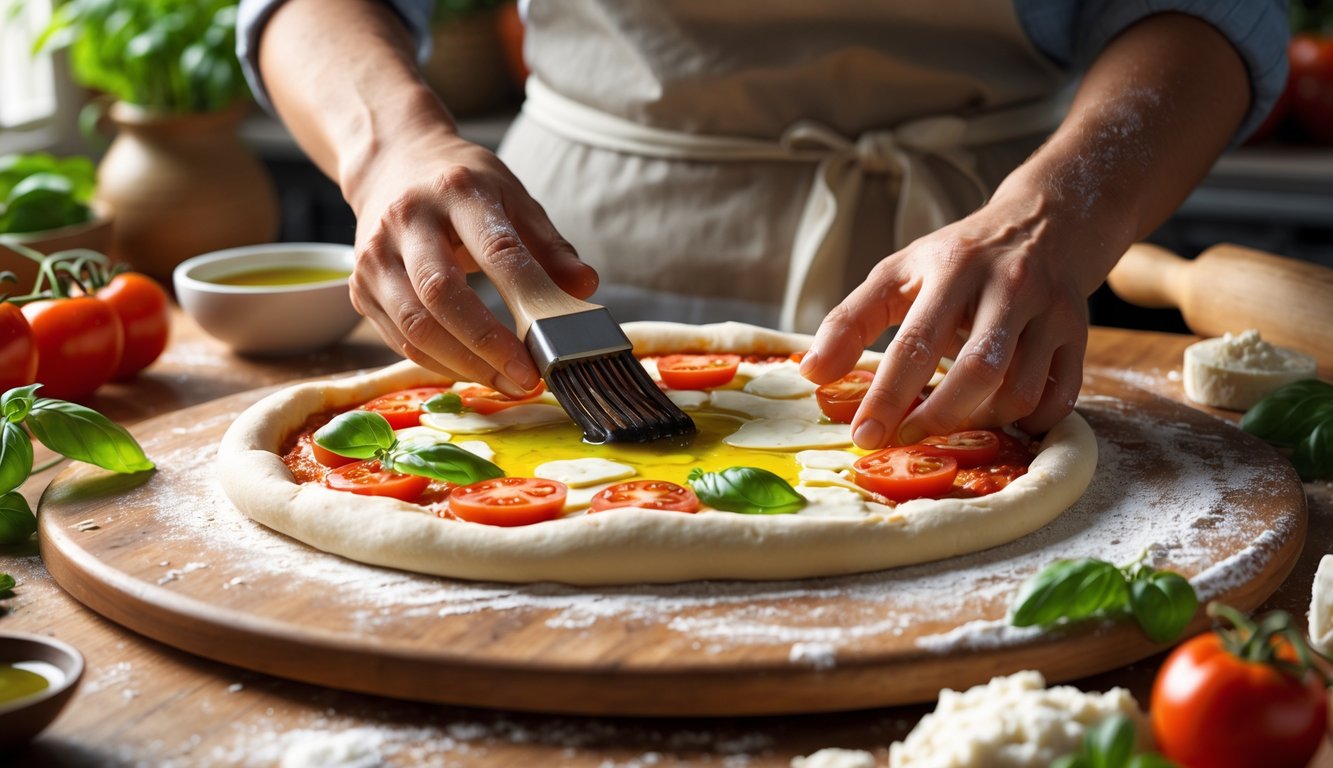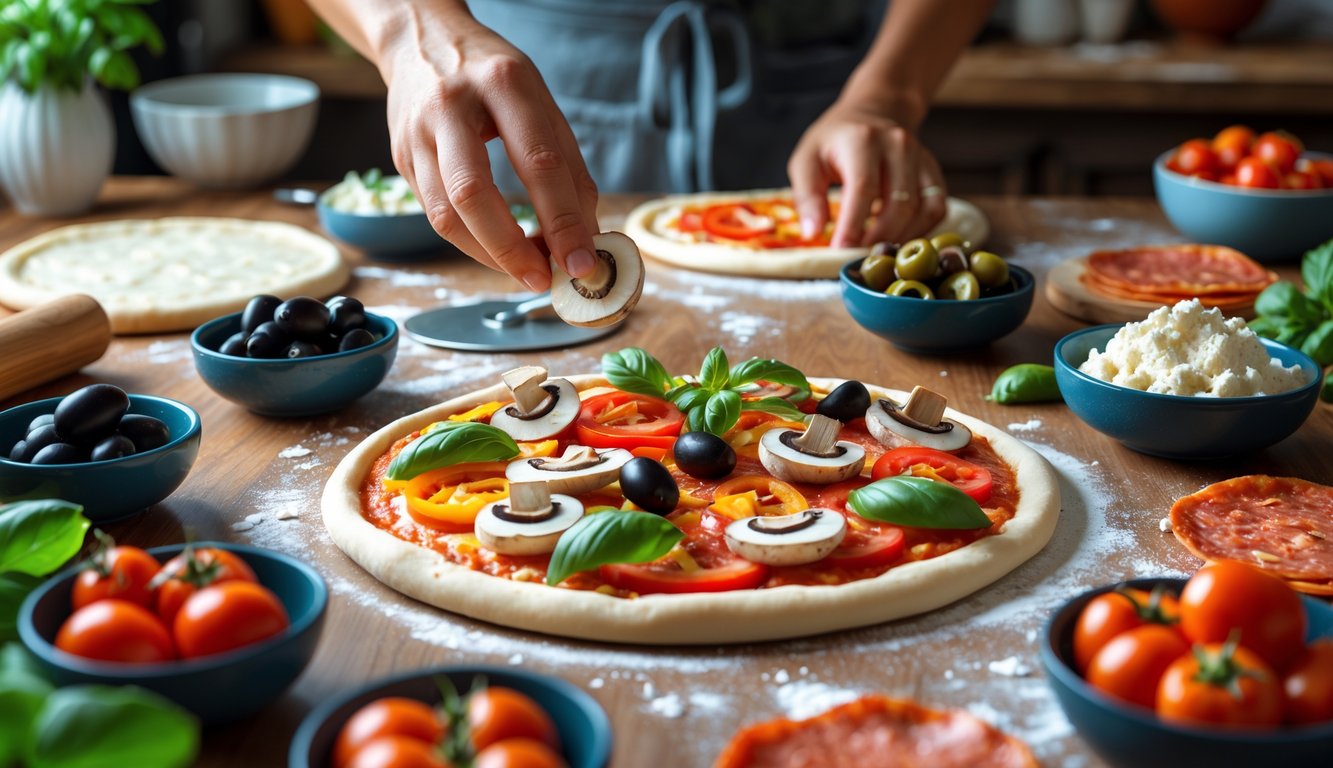
Optimal Topping Strategies

Why is it that, after years of messing with dough, my pizzas still taste like something’s missing? I’ve read all the tips, but if I get toppings wrong, it’s like the crust gives up. Wet toppings? Game over.
Choosing and Layering Toppings
One time, a friend put goat cheese on before the sauce. Chaos. Cheese welded itself to the dough, sauce slid off, and I think we just ate crackers with cheese. Sauce first, then cheese, then the heavy stuff (meats, mushrooms), and delicate things (basil, arugula) go on last or after baking. I read this guide and started watching pizzeria pros—they’re scary precise, always going light on sauce and cheese. Marco Cipolla, who I swear I’ll visit in Naples one day, says, “Less is more, always!” I pre-grate cheese and mix types, but then I forget and use cold cheese straight from the fridge, which tanks the oven temp every time. And, sorry, pepperoni goes on top. I don’t make the rules.
Managing Wet Toppings for Balance
The war on moisture is real. Tomatoes, mozzarella, pineapple—if I don’t dry or drain them, I’m left with a puddle. Thin onions? Don’t bury them. Mushrooms? Blot them or they leak everywhere. Too much moisture ruins texture way faster than burning anything. I heard from a pizzaiolo: never let spinach touch raw dough, always add it after baking. Did I listen? Nope. Ate a slice that tasted like boiled salad. Cheese helps as a shield, but watery veggies find a way. Some people swear parchment paper prevents sogginess, but I once left arugula in the oven too long and made burnt salad. Pizza crust karma is brutal and always happens when people are watching.
Finishing Touches: Garlic, Olive Oil, and Herbs
You ever finish a pizza and just feel like it’s… missing something? Like, I did all the right steps, but it’s just not memorable. The basics—tomato, cheese, dough—are there, but somehow it tastes like an idea of pizza instead of the real deal. I’m convinced the difference lives in those last two minutes, not in the hours of prep.
When and How to Add Seasonings
Honestly, I’ve watched people just dump dried oregano on a pizza and think that’s “seasoning.” Spoiler: it’s not. You ever bite into a slice and wonder if the herbs even made it to your mouth? Yeah, same. Fresh garlic, though—chop it, swirl it in olive oil, drizzle after baking—that wakes up a pizza in a way garlic powder never could. I mean, if you’re not finishing with a decent olive oil, what’s even the point? Cheese already greasy? Maybe skip it, but sometimes I want my chin to shine, so whatever. And this whole thing about throwing fresh basil on before baking? Doesn’t work. Basil goes brown and sad. Not appetizing.
I’ve tried every combo: herbs before, after, halfway, whatever. For white pizzas, garlic oil as “sauce” and then more after baking? That’s the move. It deepens the flavor but doesn’t drown the crust. I swear, crust matters more than anyone admits. (If you want proof, here’s a garlic oil tip.) There’s this weird sweet spot where basil’s just wilted and pecorino melts from the heat, but then I realize I forgot chili flakes, and now the whole thing feels off. Oh, and I dropped the olive oil bottle once—my dog loved it, so maybe that’s a win?
Inspiration From Neapolitan and Pizzaiolo Traditions
So, dough. You ever try making it and end up with glue on your hands and flour in your hair? I keep thinking pros must have some kind of secret. But no, they just make it look easy. It’s not. It’s basically wizardry.
Learning From the Experts
There’s this myth that Italian pizzaiolos have magic hands. I watched one stretch dough—no rolling pin, just fingers, and somehow the dough listens. Me? I buy the expensive 00 flour, San Marzano tomatoes (when I can find them), and still mess it up. They talk about hydration percentages and oven temps like we’re prepping a NASA launch, not dinner. Watching them hand-stretch dough, you get why the rim’s so pillowy. Machines can’t do that. Resting dough, overnight fermenting, loading a wood oven—it all adds up. I get jealous of anyone trained in Naples. Every time my dough tears, I remember: it’s not magic, it’s just stubborn, old technique. And I can’t fake it.
Troubleshooting Common Homemade Pizza Problems
Homemade pizza? Always something wrong. Floppy slice, tough crust, or “why is this so bland?” moments. It’s never “just bake it.” Fresh ingredients don’t save you if the dough’s a mess. And the internet? Everyone’s got a different “must-do,” but which blog isn’t just making it up?
Fixing Texture and Bake Issues
Getting the bottom crisp without burning the edge? Not happening in my oven. Cheese puddles in the middle, rim stays pale. Last week, underbaked crust nearly broke me. Crust Kingdom says to avoid heavy, wet toppings and let dough warm up before baking. Let it warm up—like I plan ahead, right?
Steel or stone? People argue about it. My cousin used a warped cookie tray—doesn’t count. I stick with a few toppings: mozzarella, basil, maybe one pepper. Dough thin, but not too thin, or you’ll get leaks. Not fun.
Oven thermometers lie. Mine said 525°F, but the pizza was sad and pale. Should’ve known. Crust Kingdom’s guide says to preheat, reduce topping moisture, and you’ll skip that gummy bite. Feels obvious, but apparently not.
Improving Pizza Dough Consistency
Sometimes dough cooperates, sometimes it fights. Sticky, tears, or bounces back—nothing in between. Am I over-kneading? Not enough? I read on ProFamilyChef that too much flour dries it, too little and it’s goo. No win.
Supposedly, bread flour’s better. More gluten, they say. I measure water in grams, hoping for magic, but sometimes the dough acts like a stress ball. Humidity messes with everything. July dough is not January dough. Nobody warns you.
Cold ferment overnight? Sure, if you’re a planner. I poke dough with my knuckle—if it won’t stretch, I leave it. Stretch too soon, and it rips. I started writing down which flour I used, because mystery improvements are maddening. If the dough’s a disaster, I toss it. Next time, maybe it’ll surprise me.



